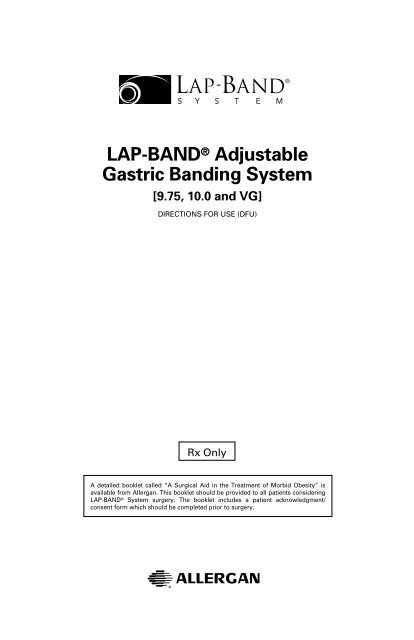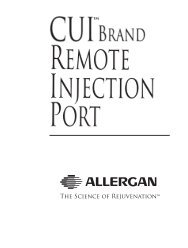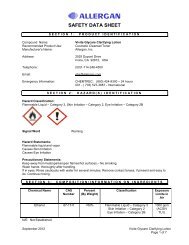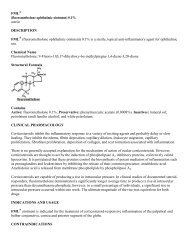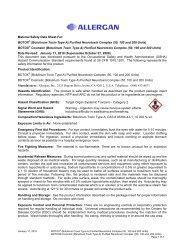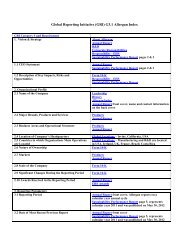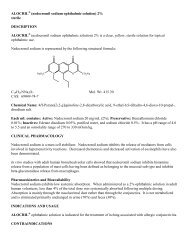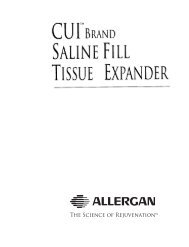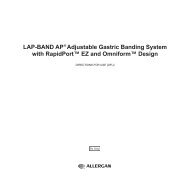LAP-BAND Adjustable Gastric Banding System – [9.75, 10.0 - Allergan
LAP-BAND Adjustable Gastric Banding System – [9.75, 10.0 - Allergan
LAP-BAND Adjustable Gastric Banding System – [9.75, 10.0 - Allergan
- No tags were found...
You also want an ePaper? Increase the reach of your titles
YUMPU automatically turns print PDFs into web optimized ePapers that Google loves.
Do not attempt to clean, re-sterilize or re-use any part ofthe <strong>LAP</strong>-<strong>BAND</strong> ® <strong>Adjustable</strong> <strong>Gastric</strong> <strong>Banding</strong> <strong>System</strong>. Theproduct may be damaged or distorted if re-sterilized.CAUTION: It is important that special care be used whenhandling the device because contaminants such as lint,fingerprints and talc may lead to a foreign body reaction.CAUTION: Care must be taken to avoid damaging theband, its inflatable section or tubing, the Access Port orthe calibration tube. Use only rubber-shod clamps toclamp tubing.CAUTION: The band, Access Port and calibration tubemay be damaged by sharp objects and manipulationwith instruments. A damaged device must not beimplanted. For this reason, a stand-by device should beavailable at the time of surgery.CAUTION: Failure to use the tubing end plug duringplacement of the band may result in damage to the bandtubing during band placement.CAUTION: Do not push the tip of any instrument againstthe stomach wall or use excessive electrocautery.Stomach perforation or damage may result. Stomachperforation may result in peritonitis and death.CAUTION: Over-dissection of the stomach duringplacement may result in slippage or erosion of the bandand require reoperation.CAUTION: Failure to use an appropriate atraumaticinstrument to lock the band may result in damage to theband or injury to surrounding tissues.CAUTION: The band is not intended to be openedlaparoscopically with surgical instruments. Unrecognizeddamage to the band may result in subsequent breakageor failure of the device.CAUTION: When adjusting band volume, take care toensure that the radiographic screen is perpendicular tothe needle shaft (the needle will appear as a dot on thescreen). This will facilitate adjustment of needle positionas needed while moving through the tissue to the port.CAUTION: When adjusting band volume, use of aninappropriate needle may cause Access Port leakageand require re-operation to replace the port. Use only<strong>LAP</strong>-<strong>BAND</strong> ® <strong>System</strong> Access Port Needles. Do not usestandard hypodermic needles, as these may cause leaks.CAUTION: When adjusting band volume, the needlemust be inserted perpendicular to the Access Portseptum. Failure to do so may cause damage to the portand result in leaks.CAUTION: When adjusting band volume never enter theAccess Port with a “syringeless” needle. The fluid in thedevice is under pressure and will be released throughthe needle.CAUTION: When adjusting band volume, once theseptum is punctured, do not tilt or rock the needle, asthis may cause fluid leakage or damage to the septum.CAUTION: When adjusting band volume if fluid hasbeen added to decrease the stoma size, it is importantto establish, before discharge, that the stoma is not toosmall. Care must be taken during band adjustmentsnot to add too much saline, thereby closing the gastricstoma. Check the adjustment by having the patient drinkwater. If the patient is unable to swallow, remove somefluid from the port, then re-check. A physician familiarwith the adjustment procedure must be available forseveral days post-adjustment to deflate the band in caseof an obstruction.CAUTION: It is the responsibility of the surgeon toadvise the patient of the dietary restrictions whichfollow this procedure and to provide diet and behaviormodification support. Failure to adhere to the dietaryrestrictions may result in obstruction and/or failure tolose weight.CAUTION: Patients must be carefully counseled on theneed for proper dietary habits. They should be evaluatedfor nutritional (including caloric) needs and advisedon the proper diet selection. If necessary to avoid anynutritional deficiencies, the physician may chooseto prescribe appropriate dietary supplements. Theappropriate physical monitoring and dietary counselingshould take place regularly.CAUTION: Patients must be cautioned to chew theirfood thoroughly. Patients with dentures must becautioned to be particularly careful to cut their food intosmall pieces. Failure to follow these precautions mayresult in vomiting, stomal irritation and edema, possiblyeven obstruction.CAUTION: Patients must be seen regularly duringperiods of rapid weight loss for signs of malnutrition,anemia or other related complications.CAUTION: Anti-inflammatory agents, which may irritatethe stomach, such as aspirin and non-steroidal antiinflammatorydrugs, should be used with caution. Theuse of such medications may be associated with anincreased risk of erosion.CAUTION: Patients who become pregnant or severelyill, or who require more extensive nutrition, may requiredeflation of their bands.CAUTION: All patients should have their reproductiveareas shielded during radiography.CAUTION: Insufficient weight loss may be caused bypouch enlargement or more infrequently band erosion,in which case further inflation of the band would notbe appropriate.CAUTION: Elevated homocysteine levels have beenfound in patients actively losing weight after obesitysurgery. Supplemental folate and vitamin B12 maybe necessary to maintain normal homocysteinelevels. Elevated homocysteine levels may increasecardiovascular risk and the risk of neuraltube abnormalities.CAUTION: Although there have been no reports ofautoimmune disease with the use of the <strong>LAP</strong>-<strong>BAND</strong> ®<strong>System</strong>, auto-immune diseases/connective tissuedisorders (i.e., systemic lupus erythematosus, scleroderma)have been reported following long-termimplantation of other silicone devices. However, there iscurrently no conclusive clinical evidence to substantiatea relationship between connective tissue disorders andsilicone implants.Adverse EventsIt is important to discuss all possible complicationsand adverse events with your patient. Complicationswhich may result from the use of this product includethe risks associated with the medications and methodsutilized in the surgical procedure, the risks associatedwith any surgical procedure and the patient’s degree ofintolerance to any foreign object implanted in the body.Perforation of the stomach can occur. Death can alsooccur. Specific complications of laparoscopic surgerycan include spleen damage (sometimes requiringsplenectomy) or liver damage, bleeding from majorblood vessels, lung problems, thrombosis, and ruptureof the wound.Ulceration, gastritis, gastroesophageal reflux, heartburn,gas bloat, dysphagia, dehydration, constipation, andweight regain have been reported after gastricrestriction procedures.3
Slippage of the band can occur. Gastro-esophagealreflux, nausea and/or vomiting with early or minorslippage may be in some cases successfully resolvedby band deflation. More serious slippages may requireband repositioning and/or removal. If there is totalstoma outlet obstruction that does not respond to banddeflation, or if there is abdominal pain, then immediatere-operation to remove the band is indicated.<strong>Gastric</strong> banding done as a revision procedure has agreater risk of complications. Prior abdominal surgeryis commonly associated with adhesions involving thestomach. In the U.S. study, 42% of the U.S. patientsundergoing revisions were reported to have developedadhesions involving the stomach.Care and time must be taken to adequately release theadhesions to provide access, exposure and mobilizationof the stomach for a revision procedure.There is a risk of band erosion into stomach tissue.Erosion of the band into stomach tissue has beenassociated with revision surgery, after the use of gastricirritatingmedications, after stomach damage and afterextensive dissection or use of electro-cautery, andduring early experience. Symptoms of band erosionmay include reduced weight loss, weight gain, AccessPort infection, or abdominal pain. Re-operation toremove the device is required.Re-operation for band erosions may result in agastrectomy of the affected area. Eroded bands havebeen removed gastroscopically in a very few cases,depending on the degree of erosion. Consultation withother experienced <strong>LAP</strong>-<strong>BAND</strong> ® <strong>System</strong> surgeons isstrongly advised in these cases.Esophageal distension or dilatation has been reportedinfrequently. This is most likely a consequence ofincorrect band placement, over-restriction, stomaobstruction, and can also be due to excessive vomiting,or patient non-compliance, and may be more likely incases of pre-existing esophageal dysmotility. Deflationof the band is recommended if esophageal dilatationdevelops. A revision procedure may be necessary tore-position or remove the band if deflation does notresolve the dilatation.Obstruction of stomas has been reported as both anearly and a late complication of this procedure. This canbe caused by edema, food, improper initial calibration,band slippage, pouch torsion, or patient non-complianceregarding choice and chewing of food.Infection can occur in the immediate post-operativeperiod or years after insertion of the device. In thepresence of infection or contamination, removal of thedevice is indicated.Deflation of the band may occur due to leakage from theband, the port or the connecting tubing.Nausea and vomiting may occur, particularly in the firstfew days after surgery and when the patient eats morethan recommended. Nausea and vomiting may alsobe symptoms of stoma obstruction or a band/stomachslippage. Frequent, severe vomiting can result in pouchdilatation, stomach slippage or esophageal dilatation.Deflation of the band is immediately indicated in all ofthese situations. Deflation of the band may alleviateexcessively rapid weight loss and nausea and vomiting,or re-operation to reposition or remove the device maybe required.Rapid weight loss may result in symptoms ofmalnutrition, anemia and related complications (i.e.,polyneuropathies). Deflation of the band may alleviateexcessively rapid weight loss.Rapid weight loss may result in development ofcholelithiasis which may result in the need fora cholecystectomy.4The following table summarizes serious adverse eventsthat were reported to have occurred during the U.S.clinical trial. Two hundred and ninety-nine patients werestudied with a total of 633 patient years.There were additional occurrences of these eventsthat were considered to be non-serious. Other adverseevents considered related to the <strong>LAP</strong>-<strong>BAND</strong> ® <strong>System</strong>that occurred in fewer than 1% of subjects included:esophagitis, gastritis, hiatal hernia, pancreatitis,abdominal pain, hernia, incisional infection, infection,redundant skin, dehydration, GI perforation, diarrhea,abnormal stools, constipation, flatulence, dyspepsia,eructation, cardiospasm, hematemesis, asthenia,fever, chest pain, incision pain, contact dermatitis,abnormal healing, edema, paresthesia, dysmenorrhea,hypochromic anemia, band leak, cholecystitis,esophageal dysmotility, esophageal ulcer, esophagitis,port dis-placement, port site pain, spleen injury, andwound infection.Serious Adverse Events Considered Relatedto the <strong>LAP</strong>-<strong>BAND</strong> ® <strong>System</strong> for the US Study(Recorded as of December 2000, 299 Patients)% ofAdverse EventpatientsBand Slippage, Pouch Dilation 11Stoma Obstruction 8Gastroesophageal Reflux 3Esophageal Dilatation 2Cholelithiasis 2Incisional Infection 2Abdominal Pain 2Gastroenteritis 2Nausea and/or Vomiting 2Port Leak 2Delayed Esophageal Emptying 1GI Perforation 1Hernia 1Band Erosion 1Chest Pain 1Dysphagia 1Infection 1Asthma 1Atelectasis 1Dehydration 1Headache 1Abnormal Healing 1Hiatal Hernia 1Improper Band Placement 1Respiratory Disorder 1Thrombosis 1Thyroid Disorder 1Death 0Twenty-seven revision procedures, involving 26 subjects(9%, 26/299) occurred. Thirteen of these 27 (48%)revision procedures were completed laparoscopically.In 9 of the 27 procedures (33%), the band was removedand replaced with a new band in the same procedure.These were due to 3 initially incorrect placements, 5stoma obstructions or band slippage/pouch dilatation,and 1 band system leakage.Two subjects were revised with a new band at separateinterventions. Sixteen of 27 revision procedures (59%)
did not require removal of the band. All of these wereperformed to correct band slippage/pouch dilatation.Six of these (37.5%) were completed laparoscopically.There were no deaths associated with <strong>LAP</strong>-<strong>BAND</strong> ®<strong>System</strong> revisions.Seventy-five subjects had their entire <strong>LAP</strong>-<strong>BAND</strong> ®<strong>System</strong>s explanted. Fifty-one of the 75 explants (68%)were counter-measures to adverse events.Band slippage/pouch dilatation and/or stoma obstructionwas the most common adverse event associated withthese explants (32% - 24/75). Other events associatedwith these explants were erosion (5% - 4/75), infection(4% - 3/75), GI disorders such as gastroesophageal refluxand/or dysphagia (11% - 8/75), <strong>LAP</strong>-<strong>BAND</strong> ® <strong>System</strong>leak (4% - 3/75); one needle damage to shell and 2Access Port tubing leaks, esophageal disorders, suchas dilatation and delayed emptying (7% - 5/75), gastricperforation (3% - 2/75), one abdominal pain, and onerespiratory disorder. Insufficient weight loss was alsoreported as a contributor to the decision to explant in24 of the 75 explants (32%). Data from a post-approvalstudy showed an estimated explant rate of 6.5% per yearover the first 5 years following implantation.All Adverse Events (Mild, Moderate, Severe)that Occurred at a Rate of 5% or More(Recorded as of December 2000, 299 Patients)Clinical Experience# of % ofpatients patientsDigestiveNausea and/or Vomiting 152 51Gastroesophageal Reflux 103 34Stoma Obstruction 41 14Constipation 27 9Dysphagia 26 9Diarrhea 22 7Abnormal Stools 18 6Body as a WholeAbdominal Pain 80 27Asthenia 25 8Incisional Infection 21 7Infection 20 7Fever 18 6Hernia 16 5Pain 16 5Chest Pain 15 5Pain Incision 14 5Band-SpecificBand Slippage/Pouch Dilation 72 24Metabolic and NutritionalHealing Abnormal 23 8Port-SpecificPort Site Pain 26 9Port Displacement 18 6Skin and AppendagesAlopecia 23 8Purpose of the Trial:The purpose of the study was to support the safety andeffectiveness of the device for use in weight reduction5for severely obese patients with a Body Mass Index(BMI) of at least 40 or those who are 100 lbs. or moreover their estimated ideal weight according to the 1983Metropolitan Life Insurance Tables (use of the mid-pointfor medium frame).The product is indicated for use only in patientswho have failed more conservative weight-reductionalternatives, such as supervised diet, exercise andbehavior modification programs.Patients who elect to have this surgery must make thecommitment to accept significant changes in their eatinghabits for the rest of their lives.Study Design:In June of 1995, a non-randomized, single-arm (noncomparative)study was initiated. The study consistedof a multi-center clinical evaluation with eight (8)participating sites and an enrollment of 299 subjects.The study was approved with patient follow-up at 3weeks, 3 months, 6 months, 9 months, 12 months,18 months, 24 months, 30 months, and 36 months.The <strong>9.75</strong>cm (B-2210) and <strong>10.0</strong>cm (B-2220) <strong>LAP</strong>-<strong>BAND</strong> ®<strong>System</strong>s were used in the study.The primary efficacy measures included the percentexcess weight loss (%EWL) at one, two, and three yearsfollowing the procedure. The differences between theseweight losses and the weight loss (gain) experienced bythe subject in the years(s) prior to placement of the <strong>LAP</strong>-<strong>BAND</strong> ® <strong>System</strong> were considered as secondary efficacymeasures. In addition, secondary efficacy measures alsoincluded changes in quality of life.The primary safety parameters included incidenceand severity of complications. These complicationswere divided into device-related and non-devicerelatedevents.Patients Studied:There were 299 patients in the U.S. study. The patientgender breakdown was 85% female and 15% male,which is consistent with gender distribution amongpatients seeking surgical treatment for severe obesity.Patient race categories were 81% Caucasian, 15%African-American and 4% Hispanic. The average age thatpatients became obese was 18.4 years and the averageage at the time of surgery was 38.8 years.The mean weight at entry was 293 pounds, and themean excess weight was 156 pounds. The meanBMI was 47.4. Thirty percent were ≥50 BMI and thusclassified as “super-obese”. During the five years priorto surgery, patients had gained an average of 54 poundsand the average BMI had increased from 39 to 47.4.In these patients, significant comorbidities included:hypertension (42%), gallstone/gallbladder disease (25%),gastrointestinal diseases (24%), asthma (16%), noninsulindependent diabetes (11%), and insulin dependentdiabetes (5%).Patient inclusion criteria:• Age 18 to 55.• Male or female.• BMI of 40 or above, or at least 100 pounds aboveestimated ideal weight.• Willingness to comply with the substantiallifelong dietary restrictions required bythe procedure.• History of obesity for at least 5 years.• History of failure with non-surgical weightloss methods.
• Willingness to follow protocol requirements,including signed informed consent, routinefollow-up schedule, completing quality-of-lifequestionnaires, completing laboratorytests, completing diet and behaviormodification counseling.• Reside within a reasonable distance from theinvestigator’s office and be able to travel tothe investigator to complete all routine followupvisits.Patient exclusion criteria:• Surgery or treatment represents an unreasonablerisk to the subject.• Family or patient history of inflammatory diseaseof the gastrointestinal tract, including gastriculceration, duodenal ulceration, Grade 2<strong>–</strong>4esophagitis, or specific inflammation such asCrohn’s disease or ulcerative colitis.• Severe cardiopulmonary disease or other seriousorganic diseases.• Severe coagulopathy, upper gastrointestinalbleeding conditions such as esophageal orgastric varices, congenital or acquiredintestinal telangiectasia.• Congenital or acquired anomalies of the GI tractsuch as atresias or stenoses.• Severe hiatal hernia.• Pregnant or has the intention of becomingpregnant in the next 12 months.• Alcohol or drug addiction.• Mentally retarded, emotionally unstable, orexhibits psychological characteristics.• Previous bariatric surgery (except <strong>Adjustable</strong>Silicone <strong>Gastric</strong> Band), intestinal obstruction oradhesive peritonitis.• Infection anywhere in the body at the timeof surgery.• Family or patient history of a known diagnosisor pre-existing symptoms of systemiclupus erythematosus, scleroderma, or otherautoimmune disease.• Participating in another ongoing clinical trial inwhich concomitant diagnostic or therapeuticintervention would adversely affect the integrityof the <strong>LAP</strong>-<strong>BAND</strong> ® <strong>System</strong> U.S. Clinical Trial.Clinical Study Methods:The primary effectiveness measure was the percentexcess weight loss (%EWL), defined as weight lossdivided by excess weight multiplied by 100. Weight losswas equal to operative weight minus selected weight.Study subjects were weighed immediately beforesurgery and postoperatively at 3 weeks, 3, 6, 9, 12,18, 24, 30, and 36 months. The 1983 Metropolitan LifeHeight and Weight Table was the scale to determineideal weight.Safety measurements were based on the patients’reported adverse events perioperatively (< 3 weeks) andpostoperatively (> 3 weeks), during scheduled visits orcalled to the attention of the study nurse or investigatorto report urgent problems.Enrollment began in June 1995 and was completedin June 1998. There were 8 centers and 12 surgeons.All procedures were completed utilizing a perigastricdissection technique with pouches of 25 ml or (later inthe study) 15 ml. 259 procedures were completedlaparoscopically, and 33 via laparotomy, including 13intraoperative conversions (4.7% conversion rate).Product Effectiveness:The following tables present data from the clinical trialthat demonstrates the effectiveness of the <strong>LAP</strong>-<strong>BAND</strong> ®<strong>System</strong> as it compares baseline data (collected beforesurgery) to data collected 36 months subsequentto surgery:Significant improvement in %EWL, weight loss, excessweight and BMI when compared to baseline wasachieved at 12, 24 and 36 months.Although most improvement was seen in the first 12months, statistically significant improvement continuedthrough month 36.Baseline 36-monthData End Point(N=292) Data (N=178)%EWL n/A 36.2%Mean Wt (lbs) 293 240.6Range 193<strong>–</strong>475 113<strong>–</strong>406Mean Excess 156 104Wt (lbs) at SurgeryRange 74<strong>–</strong>335 -15<strong>–</strong>263Mean BMI 47.4 38.7(kg/M 2 ) at surgeryRange 35.9-74.3 19.3-63.6N = Number of PatientsPrimary Endpoint: %EWLThe mean %EWL increased steadily from 9.9% atthree weeks to 37.8% at 24 months. Improvements in%EWL through 36 months were significant (p
Mean Weight by Visit (in pounds)Visit N WeightBaseline 288 293.56 months 233 254.512 months 233 241.818 months 190 240.524 months 189 234.530 months 148 235.436 months 178 240.6N = Number of PatientsSecondary Endpoint: Body Mass IndexMean BMI decreased steadily from 47.5 at baselineto 38.1 at 24 months. The improvements in BMI frombaseline were statistically significant at each visit (pairedt-test p 50) whenthey entered the study. By 12 months, only 7% of thesubjects were still super obese.Mean BMI by VisitVisit n BMIBaseline 288 47.56 months 233 41.212 months 233 39.018 months 190 38.724 months 189 38.130 months 148 38.136 months 178 38.7N = Number of PatientsSecondary Endpoint: Quality of LifeQuality of life was evaluated using several validatedinstruments, including the Beck Depression Index,the MBSR Appearance Evaluation, the RAND SF-36Mental Health Composite and the RAND SF-36 PhysicalHealth Composite. There were significant (p
7. End plug with Stainless Steel Connector (sterile),one eachNote: The <strong>LAP</strong>-<strong>BAND</strong> ® <strong>System</strong> <strong>9.75</strong> cm and <strong>10.0</strong> cmbands may be used for most patients. The <strong>LAP</strong>-<strong>BAND</strong> ®VG <strong>System</strong> provides a very slight additional range ofadjustability. After resolution of postoperative edema,most patients with appropriately placed bands reportminimal if any restriction until saline is added to theband, regardless of the size used. For re-operations(particularly conversion from other procedures) andthe pars flaccida dissection, the <strong>10.0</strong> cm band isnormally used.It is recommended that surgeons evaluate the amount oftissue within the band prior to band locking. If it appearsexcessive (the band would not fit loosely), removesome omental tissue or move the dissection closer tothe stomach wall or higher on the stomach. Additionalinformation regarding size selection is provided in thetraining program.<strong>LAP</strong>-<strong>BAND</strong> ® <strong>Adjustable</strong> <strong>Gastric</strong> <strong>Banding</strong><strong>System</strong> Features:The <strong>LAP</strong>-<strong>BAND</strong> ® <strong>System</strong> is a gastric band which, whenproperly placed through the retrogastric tunnel, formsa circular ring around the proximal stomach. All bandstransition to a silicone tube which is 50 cm long. Theband is made of silicone elastomer. The inner surfaceof the band is inflatable. The radiopaque, kink-resistanttubing is used to connect the inflatable section to theAccess Port. An end plug is provided to seal the systemwhile the band is being passed around the stomach.The <strong>LAP</strong>-<strong>BAND</strong> ® VG <strong>Adjustable</strong> <strong>Gastric</strong> <strong>Banding</strong> <strong>System</strong>with OMNIFORM ® Design employs soft, pre-curvedsections in the inflation bladder.Access Port Features:The Access Port (Figure 3) is for percutaneousadjustment of the stoma diameter and is self-sealingwhen penetrated by the Access Port needle.Figure 3. Access PortFeatures Include:1. High-compression septum; tested to over 200punctures with a 20 gauge non-coring needle.2. Titanium reservoir; positive tactile feedback,designed for long-term durability when theAccess Port needle makes contact, resistsgouging from repeated needle contact for longtermreservoir integrity.3. Radiopaque and compatible with diagnosticimaging; including MRI and CT scanning,although a minimal “halo” effect has beenreported due to the stainless steel tubingconnector. (Please refer to MRIsafety.com formore information.)4. Contoured polysulfone housing; light-weightsmooth and rounded.5. A stainless steel connector which is used withligatures to join the tubing of the band to theAccess Port.The stainless steel connector is used with ligatures tojoin the tubing of the band to the Access Port.Access Port Needle Features:The Access Port needle is a 20 gauge, 89 mm (3.5 inch)long non-coring, deflected-tip (“Huber tip”) needledesigned to penetrate the Access Port during postoperativeadjustment of the <strong>LAP</strong>-<strong>BAND</strong> ® <strong>System</strong> (seeInstructions for Use). Access port needles are availablein boxes of 10 (B-20301-10).Calibration Tube Features:The calibration tube (Figure 4) is a dual-lumentranslucent silicone tube 157 cm long with a 13 mmdiameter sensor tip at its distal end. A 15 cc to 25 ccballoon for controlled sizing and positioning of thegastric pouch is located 3.5 cm from the distal end of thecatheter. The balloon is inflated via an inflation port thatremains external during the procedure. The calibrationtube is for single use only.Figure 4. Calibration TubeFeatures Include:1. Integral inflatable gastric pouch sizer balloon.2. Inflation tubing and stopcock attached for ease infilling the calibration balloon.3. Drainage, suction and irrigation.Required Equipment and Materials (Not Included):• Atraumatic graspers• Sterile Saline (non-pyrogenic, isotonic,0.9% NaCL)• Syringe, 5 cc• 2-0 Ethibond, intestinal needle• 2-0 Dexon, cutting needle• Rubber-shod clamps (mosquito withtubing sleeves)Additional Equipment Recommended forLaparoscopic Placement:• Articulating dissector (long shaft) or Roticulatorgrasper (long shaft).• 15 mm or 18 mm trocar• 5.5 mm reducer for 15 or 18 mm trocar• 0° and 30° laparoscopes• Trocars; extra-long trocars sometimes needed• Extra-long cautery hook and suction irrigation• A set of long laparoscopic atraumatic graspers,dissectors, scissors, clip appliers, Babcock grasperand fan retractorAdditional Equipment Recommended for Placementvia Laparotomy:Surgeons electing laparoscopic placement shouldalso be prepared with the equipment necessary for8
placement via laparotomy.• Penrose Drain• Abdominal Retractor <strong>System</strong> for Obesity• Liver Retractor for ObesityUse a standard set of abdominal surgical retractorinstruments as required for laparotomy in the openplacement of the <strong>LAP</strong>-<strong>BAND</strong> ® <strong>System</strong>.Special Equipment and Materials Required forBand Adjustment:• X-ray equipment with monitor• Local anesthetic with a 1 cc syringe and30 gauge needle• Sterile 20 gauge 89 mm (3.5 in.) Access Portneedle (supplied with <strong>LAP</strong>-<strong>BAND</strong> ® <strong>System</strong> andavailable separately) or a sterile 20 gauge 51 mm(2 in.) Access Port needle (available as 10 pack:B-20302-10) or other 20 or 22 gauge non-coring,deflected tip (“Huber tip”) needle ONLY.• Sterile, non-pyrogenic isotonic saline solution ina 1 cc syringe for normal adjustments or a largersyringe when the total amount of band fluid isbeing measured.• A washer or coin for localizing the port.Operator’s ManualProphylactic AntibioticsThe perioperative administration of prophylacticantibiotics, which would cover the skin and gut flora isrecommended.Pre-operative Upper GIAll <strong>LAP</strong>-<strong>BAND</strong> ® <strong>System</strong> patients should have a preoperativeupper GI.Access Port Preparation1. Remove Access Port along with the 22 gaugeblunt flushing needle from the sterile container2. The blunt flushing needle fits loosely inside thefill tubing of the Access Port. Do not attempt toinsert it into the port3. Hold the Access Port with the fill tubing in anupright position with the port on the bottom4. Attach a 5 cc saline-filled syringe to the bluntflushing needle5. Inject sterile saline to irrigate the Access Port. Asit fills, all air and excess fluid will be forced out ofthe tubing past the blunt flushing needle6. Keep the port tubing upright until it is attached tothe band fill tubing7. The Access Port and tubing are now full of saline,mostly free of air, and ready to be attached to theimplanted band tubing<strong>LAP</strong>-<strong>BAND</strong> ® <strong>System</strong> <strong>9.75</strong>/<strong>10.0</strong> PreparationFor the Circulator1. Give Scrub Tech/RN 15 cc of sterile, nonpyrogenicisotonic 0.9% NaCl saline solution anda 10 cc syringe (without needle).2. Prior to opening the box, confirm the size andtype of <strong>LAP</strong>-<strong>BAND</strong> ® <strong>System</strong> with the surgeon.3. Do not open or throw away the sterile AccessPort Needle unless it is requested by the surgeon.If the needle is not used, label with patient’sname and give to surgeon for future <strong>LAP</strong>-<strong>BAND</strong> ®<strong>System</strong> adjustments.4. Give anesthesiologist the Calibration Tube(packaged separately).For the Anesthesiologist1. The Calibration Tube is an oral suction tube whichrequires a lubricant and 30 cc syringe for inflation.2. Surgeon will instruct anesthesiologist to removepatient’s N/G tube (if one has been inserted).Insert the Calibration Tube orally until it passesbelow the gastric-esophageal (GE) junction.3. Surgeon will ask anesthesiologist to inflateballoon with 25 cc of air (or saline) and topull back on tube until resistance is met <strong>–</strong> thisdetermines precisely where the GE junctionis located.4. Once the junction is clearly marked, the surgeonwill then instruct anesthesiologist to deflate theCalibration Tube and either retract it into theesophagus or remove it entirely.5. Discard the Calibration Tube after use only whensurgeon has completed surgery. During insertionof the calibration balloon, care must be taken toprevent perforation of the esophagus or stomach.For The Scrub Tech/RN1. After the Circulator opens outer <strong>9.75</strong>/<strong>10.0</strong> <strong>LAP</strong>-<strong>BAND</strong> ® <strong>System</strong> package, pick up inner sterilecontainer by the tab and put on back table in asecure location.2. Peel outer wrapping at the yellow indicator on thebottom side of the Tyvek and remove <strong>9.75</strong>/<strong>10.0</strong><strong>LAP</strong>-<strong>BAND</strong> ® <strong>System</strong> and priming needle.3. Connect priming needle to the <strong>9.75</strong>/<strong>10.0</strong><strong>LAP</strong>-<strong>BAND</strong> ® <strong>System</strong> tubing end.4. Fill a syringe with 5 cc of saline and connectsyringe to the priming needle. Flush the bandand inflatable shell area several times, each timedrawing out air bubbles.5. View the inflatable portion of the band forweaknesses, leaks or uneven inflation.6. Insert the end plug into the tubing end until thestainless steel tubing connector disappears into theopen end of the band fill tube <strong>–</strong> this will facilitatepulling the tube around the stomach (Figure 5).Figure 5. Insertion of Band Tubing End Plug7. Place the band in saline bowl or set asideuntil ready for insertion <strong>–</strong> It is now readyfor implantation.lap-band ® vg SYSTEM preparation1. Fill a 10 cc syringe with 10cc of saline andconnect syringe to the priming needle. Flush theband and inflatable shell area several times, eachtime drawing out air bubbles. A residual amountof saline will stay in the <strong>LAP</strong>-<strong>BAND</strong> ® VG <strong>System</strong>.9
2. View the inflatable portion of the band forweaknesses, leaks or uneven inflation.3. Inject about 5 cc saline and disconnect thesyringe. The excess saline will be forced out ofthe band, leaving about 4 cc of saline in the<strong>LAP</strong>-<strong>BAND</strong> ® VG <strong>System</strong>.4. At this point, you have replaced most of the air inthe <strong>LAP</strong>-<strong>BAND</strong> ® VG <strong>System</strong> with saline.5. Insert the end plug into the tubing end untilthe stainless steel tubing connector disappearsinto the open end of the band fill tube <strong>–</strong> this willfacilitate pulling the tube around the stomach.The tubing can be slippery. Using 4x4 gauzesponges will help grasp the tubing. (Figure 5)6. Place the band in saline bowl or set asideuntil ready for insertion <strong>–</strong> It is now readyfor implantation.7. If your patient’s anatomy requires a larger initialperimeter, the perimeter of the <strong>LAP</strong>-<strong>BAND</strong> ® VG<strong>System</strong> can be made larger by removing salinefrom the band via the Access Port. It is importantto remove any additional saline via the AccessPort so no air will enter the <strong>LAP</strong>-<strong>BAND</strong> ® <strong>System</strong>compromising later adjustments.Position of the Trocars: Four, five, or six trocars areinitially placed for this procedure. The trocars need tobe positioned high on the patient’s abdomen, and theymust be inserted so that they angle towards the gastrichiatus. This is important for better instrument accessin the severely obese abdomen. A trocar is needed forintroduction of the atraumatic grasper, usually in theright upper quadrant or below the right costal margin.A 15 or 18 mm port is required for introduction of thegastric band, usually in the left para-medial position oron the left anterior axillary line below the costal margin(Access Port site).Exposure of the Subcardial Area: A liver retractor isplaced to hold the left lobe of the liver anteriorly and tothe patient’s right to expose the esophageal hiatus, theanterior stomach and lesser omentum.Measurement of the Pouch: The anesthesiologist passesthe calibration tube down into the stomach and inflatesits balloon with 25 cc of air (some surgeons prefersaline). The balloon is withdrawn upwards until it isagainst the gastroesophageal junction (Figure 6).Maximum Fill Capacity Volumes<strong>LAP</strong>-<strong>BAND</strong> ® Max.Cat.No. <strong>System</strong> Model VolumeB-2210 <strong>9.75</strong> cm 4 ccB-2220 <strong>10.0</strong> cm 4 ccB-2250 vg 10 ccProcedure BasicsAs with other surgical decisions, it is the responsibilityof the surgeon to use his or her own judgment inutilizing the procedures best suited to the needs of thepatient and the skill and experience of the surgeon.Detailed presentations of specific procedures havebeen published. These publications and additionalinformation regarding procedures are provided in<strong>Allergan</strong> authorized <strong>LAP</strong>-<strong>BAND</strong> ® <strong>System</strong> Workshops.The following information regarding the surgicalprocedure, adjustments and band removal is intendedto supplement, not replace, information provided inthese workshops.<strong>LAP</strong>-<strong>BAND</strong> ® <strong>System</strong> Surgical ProcedureAnesthesia: The anesthesiologist typically avoidsmask ventilation prior to intubation in order to preventaspiration of gastric contents into the respiratory tract.Crash induction of anesthesia (injection of anestheticdrugs followed immediately by intubation undercricoid compression) is common in obesity surgery. Anasogastric tube is typically placed after intubation inorder to empty the stomach.Position of the Patient and the Surgeon: The patientis most commonly placed in a lithotomy position, in amoderate anti-Trendelenburg tilt. The hips and the kneesare slightly flexed in order to prevent the patient fromslipping down the table. This position helps displacethe intra-abdominal viscera and the fatty omentumdownwards so that the upper part of the stomach maybe better visualized. The surgeon stands between thepatient’s legs, the first assistant on the patient’s left sideand the second assistant on the patient’s right.Pneumoperitoneum: The laparoscopic procedure isperformed under carbon dioxide pneumoperitoneum.Pressure is monitored constantly.Figure 6. Calibration Tube balloon withdrawn upwardsagainst the gastroesophageal junction.This permits correct selection of the location along thelesser curvature and into the phrenogastric ligament toperform the blunt dissection (Figure 7).Figure 7. Calibration Tube balloonand dissection point selected.Lesser Curve Dissection OptionsRecommended TechniquePARS FLACCIDA: Dissection begins directly lateral tothe equator of the calibration balloon in the avascularspace of the Pars Flaccida. After seeing the caudatelobe of the liver, blunt dissection is continued underdirect visualization until the right crus is seen, followedimmediately by the left crus over to the Angle of His.The PARS FLACCIDA technique is recommended as it isthe most widely used method for laparoscopic adjustablegastric banding and results in a reduced incidence of10
gastric prolapse and pouch dilatation compared to thePERI-GASTRIC technique (described below).Alternate TechniquesPERI-GASTRIC TECHNIQUE: Dissection starts directlyon the lesser curve at the mid-point (equator) of thecalibration balloon. Dissection is completed behindthe stomach toward the Angle of His under directvisualization, taking care to avoid the lesser sac. Retrogastricsuturing is an option (Figure 8).dissection may result in movement or erosion of theband. A blunt instrument is gently passed through theretrogastric tunnel.Introduction and Placement of the Band: The inflatableband and Access Port are flushed with sterile saline (see“Band Preparation” and “Access Port Preparation”). Theband is introduced into the abdomen via a 15 mm or 18mm trocar. The band is pulled end plug first into placearound the stomach with the instrument previouslyplaced through the retrogastric tunnel (Figure 10).Figure 8. Dissection of the lesser curvature.PARS FLACCIDA TO PERI-GASTRIC TECHNIQUE:Dissection begins with the Pars Flaccida technique(above). A second dissection is made at the mid-point(equator) of the balloon near the stomach until the perigastricdissection intercepts the Pars Flaccida dissection.The band is then placed from the Angle of His throughto the peri-gastric opening.Under direct vision, the full thickness of thehepatogastric ligament is dissected from the gastric wallto make a narrow opening. The posterior gastric wallshould be clearly recognizable. The dissection should bethe same size as the band or even smaller to reduce thepossibility of band and/or stomach slippage.Dissection of the Greater Curvature: A very smallopening is created in the avascular phrenogastricligament, close to the gastric wall at the Angle of His.Retrogastric Tunnel: Always under direct vision, bluntdissection is continued towards the Angle of His untilthe passage is completed (Figure 9).Figure 10. Placement of the band.The tubing is inserted into the band’s buckle. The bandis locked in place with atraumatic graspers.CAUTION: Failure to use an appropriate atraumaticinstrument to lock the band may result in damage to theband or injury to surrounding tissues.Retention Gastro-gastric Sutures: Multiple nonabsorbablesutures are placed between theseromuscular layer of the stomach just proximal anddistal to the band. Sutures should be placed from belowthe band to above the band, pulling the stomach up overthe band until the smooth surface of the band is almostcompletely covered. The tubing and buckle area shouldnot be included in the gastro-gastric imbrectation(Figure 11).Figure 11. Suturing the greater curvatureover the <strong>LAP</strong>-<strong>BAND</strong> ® <strong>System</strong> and pouch.Figure 9. Posterior instrument passage.CAUTION: Do not push the tip of any instrument againstthe stomach wall or use excessive electrocautery.Stomach perforation or damage may result. Stomachperforation may result in peritonitis and death.CAUTION: Any damage to the stomach during theprocedure may result in erosion of the device into theGI tract.CAUTION: Do not over-dissect the opening. ExcessiveAccess Port Placement and Closure: The band tubing isbrought outside the abdomen and is connected to theAccess Port. The port is then placed on, or in the rectusmuscle or in an accessible subcutaneous site. The tubingmay be shortened to tailor the position of the port to thepatient while avoiding tension between the port and theband. The two components are joined with the stainlesssteel tubing connector. Ligatures may be placed on bothtubing ends over the connector. The Access Port is thenfixed in place, using suturing or other fixation method.The trocar holes are closed.11
Instructions for Use:Band AdjustmentPostoperatively, the surgeon may adjust the stoma sizepercutaneously by injecting or aspirating saline with theAccess Port needle via the self-sealing Access Port.The following are general guidelines for <strong>LAP</strong>-<strong>BAND</strong> ®<strong>System</strong> adjustments:1. The initial adjustment postoperatively shouldoccur at six weeks or more after operation andusually 1-2 cc of normal saline would be addedfor the <strong>9.75</strong> and <strong>10.0</strong> cm <strong>LAP</strong>-<strong>BAND</strong> ® <strong>System</strong>s.Between 1-3 cc of normal saline would be addedfor the <strong>LAP</strong>-<strong>BAND</strong> ® VG <strong>System</strong>.2. The patient should be reviewed regularly, (every4-6 weeks) depending on patient need, andweight and clinical status measured. If the weightloss has averaged less than 1lb per week overthe period and the patient indicates there is notexcessive restriction to eating, a further incrementof fluid should be added.3. Where the average weight loss between visits hasbeen greater than 2 lbs per week, normally noadditional fluid would be added.4. If the weight loss averaged between 1 and 2 lbsper week, additional fluid would be indicated if thepatient felt he/she could eat too freely or founddifficulty in complying with the dietary rules.5. Fluid should be removed from the system ifthere were symptoms of excessive restrictionor obstruction, including excessive sense offullness, heartburn, regurgitation and vomiting.If symptoms are not relieved by removal of thefluid, a barium meal should be used to evaluatethe anatomy.Prior to doing an adjustment to decrease the stoma,review the patient’s chart for total band volume andrecent adjustments. If recent adjustments have not beeneffective in increasing restriction and the patient hasbeen compliant with nutritional guidelines, the patientmay have a leaking band system, or may have pouchenlargement or esophageal dilatation due to stomalobstruction, band slippage or over-restriction.Band <strong>System</strong> patency can be confirmed by injectingsaline into the band system, then immediatelywithdrawing it. An absence or decrease in fluid volumeindicates a leak in the system may exist. The band maybe evaluated for a leak using a radiopaque solution,such as Hypaque or Conray-43, flushing it from the bandsystem after the evaluation. If pouch enlargement orband/stomach slippage is suspected, a limited upper GIwith a small amount of barium or gastrografin can beused to evaluate the size of the pouch, the gastric stomaand the position of the band.CAUTION: Insufficient weight loss may be a symptomof inadequate restriction (band too loose). Or, it maybe a symptom of pouch or esophageal enlargement,and may be accompanied by other symptoms, such asheartburn, regurgitation or vomiting. If this is the case,inflation of the band would not be appropriate.Excessive restriction may result in a closed stoma.Because of the possible complications that can occurwith excessive restriction, a doctor familiar with theadjustment procedure must be available for severaldays post-adjustment to adjust the stoma in case of anemergency. (See CAUTION after step 10).Deflation (an increase in stoma size) is considered ifthe patient experiences frequent episodes of vomiting,is unable to swallow liquids or appropriate foods, orif there are medical indications for increasing nutrientintake. The internal diameter of the band can beincreased approximately 0.5mm by withdrawing 0.4ccof the fluid. Elective deflation of the band is advisable inthe following situations:• Pregnancy• Significant concurrent illness• General anesthesia• Remote Travel• Travel to areas where food or watercontamination is endemicCAUTION: Esophageal distension or dilatation has beenreported and may be associated with stoma obstructiondue to incorrect band placement or over-restriction, dueto excessive band inflation. Patients should not expectto lose weight as fast as gastric bypass patients, andband inflation should proceed in small increments.Deflation of the band is recommended if esophagealdilatation develops.If esophageal dilatation is present, then steps should betaken to identify and resolve the cause(s). Deflation ofthe band may resolve dilatation which are entirely dueto over-restriction. Dietary evaluation and appropriatenutritional counseling regarding correct eating behaviorshould follow band deflation and precede subsequentgradual re-inflations. Re-inflation of the band should beconducted gradually in small increments over severalmonths. Dietary counseling should be ongoing, andrepeat upper GI exams should be done at each bandinflation to evaluate the esophagus.Band deflation may not resolve the dilatation if thestoma obstruction is due to a significant gastricslippage or if the band is incorrectly placed aroundthe esophagus. Band repositioning or removal maybe necessary if band deflation does not resolvethe dilatation.Adjustment of Port Located Within RectusSheath and/or Deep below Adipose TissueThe Access Port’s white plastic housing is notradiopaque. Only the internal titanium portal housingis visible on x-ray. An ideal overhead view (0°) of theAccess Port shows two concentric rings for the <strong>9.75</strong>cmand <strong>10.0</strong>cm <strong>LAP</strong>-<strong>BAND</strong> ® <strong>System</strong>s. (Figure 12a).Figure 12a. Top or bottom viewx-ray image of the Access Port.The <strong>LAP</strong>-<strong>BAND</strong> ® VG <strong>System</strong>’s Access Port includesa single radiopaque dot (Figure 12b) in the port todistinguish it from the ports used with the <strong>9.75</strong> and<strong>10.0</strong> cm <strong>LAP</strong>-<strong>BAND</strong> ® <strong>System</strong>s.Be aware that an upside down (180°) port showsthe same image. The largest diameter portion of thetitanium portal housing is at the top of the Access Port(Figure 13).This large round titanium area holds the self-sealingseptum. The smaller portion is the fluid chamber. Accessports have been reported to be “flipped” or invertedbased on an oblique or side view of the port beingmisinterpreted. If you initially see an oblique (Figure 14)12
Figure 12b. X-ray of the <strong>LAP</strong>-<strong>BAND</strong> ® VG <strong>System</strong> accessport with “free floating” radiopaque dot in center.or side view (Figure 15) on x-ray, then either repositionthe patient or the x-ray equipment until you obtain aperpendicular, overhead (0°) view. Targeting the port forneedle penetration can be difficult if this orientation isnot controlled.Figure 13. Cross-section view of the Access Port.Figure 14. Access Port, oblique view.Figure 15. Access Port, side view.Steps for Performing an Adjustment1. Shield the reproductive organs of all patients.2. Wash your hands with a germicidal solution.Sterile gloves are advised. Always penetrate theAccess Port using aseptic technique.3. Complete a skin prep with an antiseptic solution.4. Locate the Access Port radiologically: placea small metal object (coin, washer, or use anAccess Port needle as a pointer) on the abdomenand move it as necessary to position it exactlyover the center of the port. Make a circle aroundthe object to mark the injection site.5. Local anesthesia may be used to eliminate painduring injection.6. Position the needle perpendicularly to the septumof the Access Port (Figure 16).CAUTION: When adjusting band volume, the needlemust be inserted perpendicular to the Acces Portseptum. Failure to do so may cause damage to the portand result in leaks.CAUTION: Use of an inappropriate needle may causeAccess Port leakage and require reoperation to replacethe port. Do not use standard hypodermic needles asthese may cause leaks. Use only <strong>LAP</strong>-<strong>BAND</strong> ® <strong>System</strong>Access Port Needles.CAUTION: Take care to ensure that the radiographicscreen is perpendicular to the needle shaft (the needlewill appear as a dot on the screen). This will facilitateadjustment of needle position as needed while movingthrough the tissue to the port.7. When the AccessPort is felt, and justprior to penetratingit, confirmradiographicallythat the needle isproperly positioned.Attach a syringe tothe needle beforepenetrating the port.A one-way stopcockcan be connected tothe needle to preventfluid loss.CAUTION: Never enterthe Access Port with a“syringeless” needle.The fluid in the device isunder pressure and will bereleased through the needle.Figure 16. Needleand Access Port.8. Penetrate the Access Port. The port must bepenetrated until the needle is stopped by thebottom of the portal chamber. Withdraw somesaline to confirm that the bevel of the needle iswithin the port. If, after penetration, the salinesolution cannot be withdrawn or injected, thebevel of the needle may be occluded by the portseptum. Try to advance the needle further intothe port to the bottom of the portal chamber. Ifyou cannot advance, then re-enter the port withanother sterile needle.CAUTION: Once the septum is punctured, do not tiltor rock the needle, as this may cause fluid leakage ordamage to the septum.9. To increase stoma size: Taking into account anyfluid withdrawn to confirm port penetration,remove fluid to deflate the band and increasethe stoma size. Take care to remove only enoughfluid to deflate the band; avoid creating a vacuum.10. To decrease stoma size: Taking into account anyfluid withdrawn to confirm port penetration, injectadditional saline to further inflate the band anddecrease the stoma size.CAUTION: Important: If fluid has been added todecrease the stoma size, it is important to establish,before discharge, that the stoma is not too small. Checkthe adjustment by having the patient drink water. If thepatient is unable to swallow, remove some fluid fromthe port, then recheck. A physician familiar with theadjustment procedure must be available for severaldays post-adjustment to deflate the band in case ofan obstruction.13
Adjustment Following SignificantWeight LossOnce significant weight has been lost it may becomepossible to palpate and locate the Access Port withoutx-ray. If this is the case, complete all the other steps, skinprep, aseptic technique, etc. An evaluation of the stomaand pouch size is recommended via a gastrografinor limited barium swallow prior to and followingadjustments. This is important to avoid inadvertent overinflationof the band and possible stoma obstruction.Band RemovalThe band can be removed if necessary. The bandis usually surrounded by a thin, clear capsule. Afterentering the abdomen via laparotomy or a laparoscopicapproach, cut open the capsule and cut the buckleportion of the band under and behind the locking head.Cut the tubing where it attaches to the band and pull theband out buckle first, to avoid pulling the buckle behindthe stomach. Remove the Access Port and remainingtubing. Close the wounds.Returned Goods PolicyAuthorization must be received from customerservice at <strong>Allergan</strong> prior to return of the merchandise.Merchandise returned must have all the manufacturer’sseals intact to be eligible for credit or replacement.Products returned may be subject to restocking charges.Special NoticeThe manufacturer of the <strong>LAP</strong>-<strong>BAND</strong> ® <strong>Adjustable</strong> <strong>Gastric</strong><strong>Banding</strong> <strong>System</strong> has designed, tested and manufacturedit to be reasonably fit for its intended use. However, the<strong>LAP</strong>-<strong>BAND</strong> ® <strong>System</strong> is not a lifetime product and itmay break or fail, in whole or in part, at any timeafter implantation and notwithstanding the absenceof any defect. Causes of partial or complete failureinclude, without limitation, expected or unexpectedbodily reactions to the presence and position of theimplanted device, rare or atypical medical complications,component failure and normal wear and tear. Inaddition, the <strong>LAP</strong>-<strong>BAND</strong> ® <strong>System</strong> may be easilydamaged by improper handling or use. Please refer tothe adverse events section in this document and to theInformation for Patients booklet for a presentation of thewarnings, precautions, and the possible adverse eventsassociated with the use of the <strong>LAP</strong>-<strong>BAND</strong> ® <strong>Adjustable</strong><strong>Gastric</strong> <strong>Banding</strong> <strong>System</strong>.Authorized Training Program andProduct Ordering Information<strong>LAP</strong>-<strong>BAND</strong> ® <strong>System</strong> Placement is an advancedlaparoscopic procedure. Surgeons planning <strong>LAP</strong>-<strong>BAND</strong> ®<strong>System</strong> placement must participate in a <strong>LAP</strong>-<strong>BAND</strong> ®<strong>System</strong> training program authorized by <strong>Allergan</strong> or anauthorized <strong>Allergan</strong> distributor. This required trainingprogram is specific to the <strong>Allergan</strong> <strong>LAP</strong>-<strong>BAND</strong> ® <strong>System</strong>and does not qualify for use with other gastric bands.For additional information please contact:Manufacturer and Distributor<strong>Allergan</strong>5540 Ekwill StreetSanta Barbara, CA 93111Tel: (805) 683-6761Fax: (805) 681-5765CAUTION: This device restricted to sale by or on theorder of a physician.The <strong>LAP</strong>-<strong>BAND</strong> ® <strong>Adjustable</strong> <strong>Gastric</strong> <strong>Banding</strong> <strong>System</strong>contains no latex or natural rubber materials.The <strong>LAP</strong>-<strong>BAND</strong> ® <strong>System</strong> is MRI safe and compatible.The <strong>LAP</strong>-<strong>BAND</strong> ® <strong>Adjustable</strong> <strong>Gastric</strong> <strong>Banding</strong> <strong>System</strong> andaccessories are covered by the following U.S. Patents:5,601,604; 5,658,298.14
YYYY/XXSterile, Dry Heat Sterilized, Date of Sterilization,Year & MonthAttention! See instructions for use.Single Use Only. Do Not Reuse.YYYY/XXUse By Year & MonthManufacturerYYYY/XXDate of Manufacture, Year & MonthSNSerial NumberREFCatalog NumberContains no latexThis device restricted to sale by or on the order of a physician.
Manufacturer<strong>Allergan</strong>5540 Ekwill StreetSanta Barbara, CA 93111, USATel: (805) 683-6761Fax: (805) 681-5765www.lapbandcentral.com0123HM0670 94800-17 9/10® Marks owned by <strong>Allergan</strong>, Inc. All rights reserved. © 2009 <strong>Allergan</strong>, Inc., Irvine, CA


